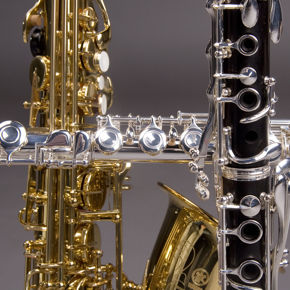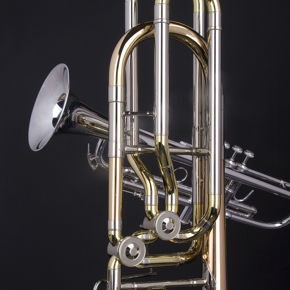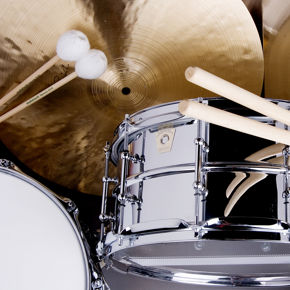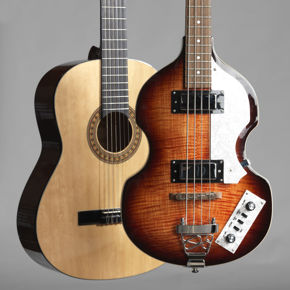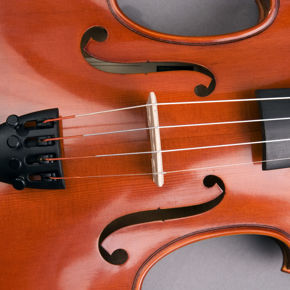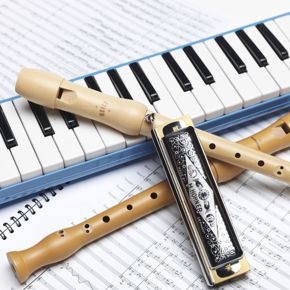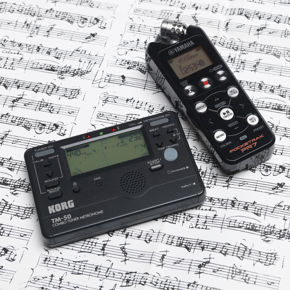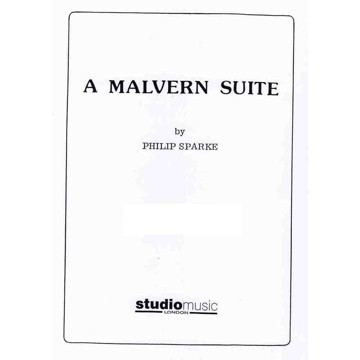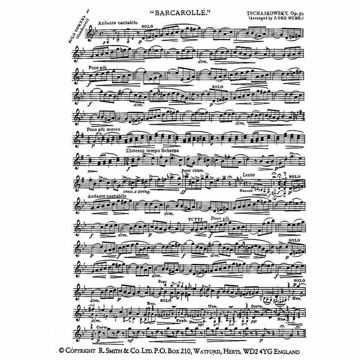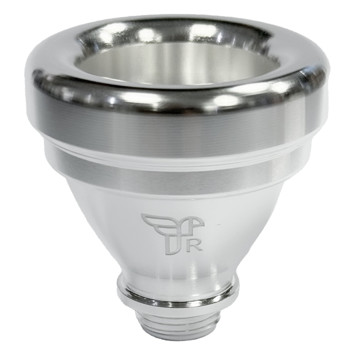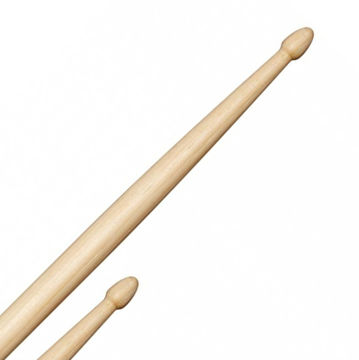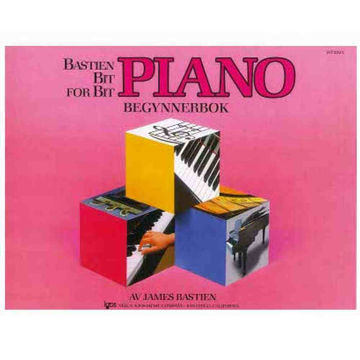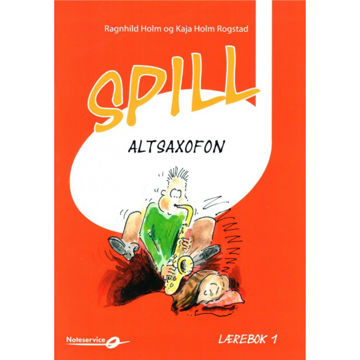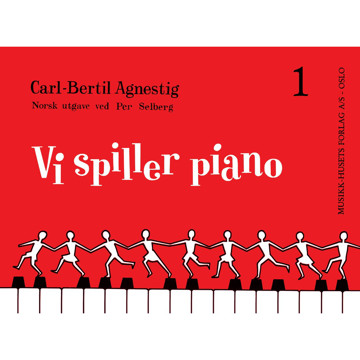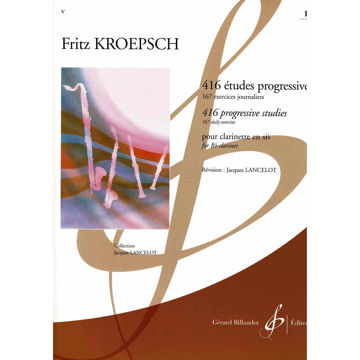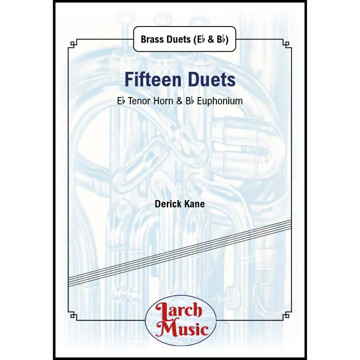Menu
Søk
Personal menu
Close
Menu
Relaterte produkter
Varen er på lager
La Califfa, Ennio Morricone arr Stuart Pullin. Eb or Bb Cornet Soloist and Brass Band
La Califfa, Ennio Morricone arr Stuart Pullin. Soprano cornet soloist and Brass for Peter Roberts
839 kr
Varen er på lager
SVoR Three Norwegian Folksongs, Torstein Aagaard-Nilsen. Brass Band
SVoR - Torstein Aagaard-Nilsen. Brass BandTorstein Aagaard-Nilsen (b. 1964, Norway) is one of Norway's finest composers and has gained an international reputation for his music for Brass- and Wind Bands and Ensembles. The broad spectre of musical activity, the versitality in his production and his interest in working with amateurs and young musicians, can be explained by the fact that Aagaard-Nilsen sees composition as a kind social activityHis contact with the contemporary music scene in Bergen resulted in commissions from the Norwegian section of ISCM, the BIT 20 Ensemble and festivals like Borealis (Bergen International Contemporary Music Festival) and the International Festival of Bergen (Festspillene).Prima Vista is delighted to re-release one of his early works for brass band SVoR - a superb suite based on three Norwegian folksongs:I - Springdans II - Vuggesang III - Reinlender
1249 kr
Varen er på lager
Elemental, Philip Harper. Brass Band
The opening number in Cory Band's 2015 'Four Elements' themed Brass in Concert programme, this piece sets out a mysterious introduction transporting us back to the time of the Greek Philosophers, after which it presents short musical depictions of Fire, Air, Water and Earth. Designed to start your concert with a bang.
825 kr
Varen er på lager
A Fantasy of Joy, Fredrick Schjelderup. Brass Band
A Fantasy of JoyA Fantasy of Joy was commissioned and first performed by the World-famous Black Dyke Band.The piece was written in 2020, as a tribute and celebration of Ludwig van Beethoven's 250th Anniversary. The main theme and inspiration of the piece come from his famous 9th Symphony with the famous tune Ode to Joy.Product informationComposer Fredrick SchjelderupInstrumentation Brass BandDuration 3'30"Difficulty Level Difficult
695 kr
Andre kjøpte også
Varen er på lager
Bastien Bit for Bit Begynnerbok Piano
Fra James Bastien og Jane Smisor Bastien, to av de meste betydningsfulle navn i pianopedagogikk i verden i dag....... Nye bøker på norsk.* Klar konsis lett å følge* Illustrasjonene er fargerike, morsomme, vakre....glimrende for motivasjonen.* Lakkerte omslag gjør at de holder lenger.* Praktiske lærertips hjelper eleven å utvikle gode øvevaner.* Side for side oversikt i alle bøker sparer tid til forberedelse og hjelper til med å repetere og oppfriske viktige konsepter.Helt ny musikk:* Helt nye Bastien originale og kreative arrangementer* Stimulerende blanding av pop, folkemusikk, klassisk og moderne musikkstiler.* Venstrehånds utfordringer og variasjon.* Lærer duetter (Begynnerdel og del 1).Gjennomprøvet pedgogikk - Kvalitet du kan stole på!* Stol på Bastien-navnet. Tillit, suksessfull, aktiv - Jane Bastien underviser fortsatt 5 dager i uka. Bastien er eksperter på hva som fungerer på unge pianoelever.* Logiske avsnitt - Vel-organisert , vel gjennomtenkt. Hvert element utvikles logisk til det neste, i et tempo eleven kan mestre komfortabelt og trygt.* Klar presentasjon følger 3 grunnleggende prinsipper om god læring: 1. Det er lett å forstå introduksjonene til et nytt konsept, 2. umiddelbar trening, 3. konstant repetisjon.* Systematisk oversikter * Gradvis toneartutvidelse.... Tar eleven gjennom alle 12 tonearter gjennom slutten av bok 4.* Utvikler sterk notelesing.* Lærer de viktige grunnprinsippene...rytmikk, intervaller, akkorder, skalaer og de viktigste symboler og musikktermer.* Lærer elevene hvordan å undervise seg selv. Elevene lærer hvordan de skal analysere. De lærer ikke bare notene og fakta, men selve læringsprosessen så de kan fortsett å utvikle sin musikalske evner gjennom livet.
189 kr
Varen er på lager
Notemappe - Innovative Music Folder Standard A4/40
INNOVATIVE MUSIC FOLDEREn utrolig smart notemappe! 20 sider med plass til 40 ark (for/bakside).Sidene er åpen i midten slik at man kan skrive direkte på noten uten å måtte ta dem ut av plasten.Du unngår lysrefleksjon fra plastomslaget.Lomme for navnelapp (2 lapper følger med)DESCRIPTIONInnovative Music Folder 'Standard' A4/40 good to know: for DIN A4 / 20 sheets (40 pages)SPECIFICATIONSInstrument Group GiftsProduct Type FolderBrand Agifty.AtYear of Publication 2021EAN 9006061019129Edition Number F 1019No. AGFTYF1019
215 kr
Varen er på lager
Spill Altsax 1, Ragnhild Holm/Kaja Holm Rogstad
Spill Altsaxofon 1Lærebok - Ragnhild Holm-Kaja Holm Rogstad - Elisabeth VanneboPRODUKTBESKRIVELSETil læreren«Spill saxofon» er en nybegynnerbok som er beregnet på undervisning i musikk- og kulturskoler, skolekorps eller for de som tar saxofontimer privat.Denne boken er én av mange bøker i serien «Spill» som er utarbeidet for de fleste instrumentene som representeres i et korps. Flere av melodiene og toneartene er valgt slik at ulike instrumenter kan spille sammen. Vi har likevel lagt vekt på å få til en god progresjon for de som vil lærer å spille saxofon. Av den grunn kan ikke alle melodiene i Bb-boken (sopran- og tenorsaxofon) og Eb-boken (alt- og barytonsaxofon) spilles parallelt.Så snart eleven mestrer et større toneomfang kan melodiene transponeres, slik at elever med Bb- og Eb-instrumenter kan spille sammen. Flere av melodiene i boken er spilt inn med melodistemme og komp som kan lastes ned eller streames fra iTunes, Wimp, Spotify eller liknende. De fleste melodiene i «Spill saxofon» har også besifring i C.I denne boken har vi lagt vekt på at elevene gjennomfører «Daglige øvelser (D.Ø.)» for å oppnå en god klang. For å få god fingerteknikk legges vekt på å spille skalaer, tersbevegelser og brutte akkorder. Gehørspill er en viktig del av opplæringen. De foreslåtte tonene i D.Ø.1 og i gehørmelodiene er valgt i forhold til skalaene. Elev og lærer kan også finne andre melodier som eleven har lyst til å spille. Elevene bør også spille melodier fra boken utenat og lage små komposisjoner selv. Vi anbefaler å kombinere denne boken med supplerende bøker, for eksempel L alphabet du Saxophoniste av Hubert Prati (Gerard Billadot) og etter hvert 23 Minipuzzles av samme forfatter. Når elevene arbeider med flere elementer samtidig, vil progresjonen gå raskere og elevene vil mestre instrumentet på en god måte på et tidlig tidspunkt. Dette vises i «Leksebok» på neste side der vi har satt opp forslag til en hjemmelekse.«Spilletest» finner du mot slutten av boken. Den består av skala, gehørspill og fire melodier, der læreren kan godkjenne hvert nivå. Dette kan gi ekstra motivasjon for elevene til å øve.«På skolen» inneholder melodier knyttet til fag i skolen. Melodiene i denne delen har samme toneart i alle bøker, slik at elevene kan spille sammen. Dette gjelder også de tre siste melodiene i boken som vi har kalt «Samspill med andre».Siste del av boken inneholder notelære, noteark, oppgaver i arrangering og terningspill.Greptabellen på siste side inneholder toner ut over de som elevene lærer i denne boken.Øvefisken er ment som motivasjon for øving og står på side 6 i boken. Lag kopier av denne.I EMNEHEFTE 10 som tidligere ble utgitt av NMF: Berntzen, Mette, Ragnhild Holm og Harald Bergersen (revidert 2002) Om det å spille klarinett/saxofon. Norsk noteservice / notebutikken.no, finnes utdypende informasjon som gjelder saxofonundervisning. Her kan sidene om «historikk, munnstykker og rør, pust, munnstilling og holdning, hvordan øve opp en god klang og bra embouchure, fingerteknikk, artikulasjon og tungeteknikk, om øving» være relevant lesning.Lykke til med arbeidet!Ragnhild Holm og Kaja Holm RogstadInnhold:TeoriMin sideøvefiskMedvirkendeOM INSTRUMENTETDETTE TRENGER DUSTELL OG VEDLIKEHOLDSTÅ, SITTE og MUNNSTILLInGPUSTENØVELSER for FingreneSKALASPILLANSATSER med TUNGENTUNGEØVELSERDine første tonerLegatobueHalvnoter og halvpauserFiredels noter og firedelspauserHelnoter og helpauserRepetisjonstegnÅttendels noter og pauserKryss hever tonen et halvt trinn2/4Pustetegnsenker tonen et halvt trinnD.S . al FineOppløsningstegn / opphevelses tegnD.C. al FineFermateOpptakt3/4BindebuePunkterte firedels noterOKTAVKLAFFLØSE FORTEGNFIRE TAKTER PAUSEKOMPOSISJ0NHUSImprovisereDynamikkIntervallerGJETTELEKAlla BreveMOLLOppgaveCrescendoJUlesangerBursdagerSpilletreningPå skolenGamle kulturer, EgyptGamle kulturer, HellasVikingtidenOppdagelsen av AmerikaNotelæreLag dine egne arrangementerNotearkGreptabellSanger / noter:Ah Ya ZainALL MY LOVINGANSATSØVELSEARABISK SKALAÅttendelsØVELSEAura LeeBalladen om Davy CrockettBARCAROLEBirgits nye hotellBjelleklangbjørnen soverBlåveis pikenBLOMSTER SMÅBLUES SKALABOBOBolla Pinns vinBrandenburger TorCan CanCAN CAN I ALLA BREVECISSØVELSECountry WalkDari dariDeilig er jordenDET VAR EN GANG ET TROLLDu kjære lille snekkerbuDUR OG MOLL TREKLANGERDYNAMIKKØVELSEFISSØVELSEFløy en liten blåfuglFordFredagskosGammal fäbodssalmeGavotteGilde i ValhalGISS ØVELSEGodnatt-rimHans og Grete!Happy BirthdayHEI HÅHELNOTEØVELSE som DUETTHey hoe, digga joeHistorien om de tre små fiskHokus og PokusHujeda megHurra for degHvileviseIndisk silkeIntervallsangJag gör så att blommorna blommarJeg er så glad hver julekveldJEG HAR FANGET MEG EN MYGGJEG KAN SPILLE SAXOFONJULEKVELDsVISAKalinkaKamomilla spillerKarius og BaktusKiss me, Honey, HoneyKOM OG BLI MEDKVELDSSANG FOR BLAKKENLILLE FUGL MED VARIASJONERLille kattLille kattLirekassenLofottorskenLook at me I m Sandra DeeMange trær i skogen stårMatpakkespiseviseMatpakkespiseviseMIAMIN EGEN MELODIMin konsertdebutMin nye saxofonMorgenstemningMunnstykkeduettMustalainenNå tennes tusen julelysOde to JoyOKTAVKLAFFØVELSE D2oktavøvelseOrmen LangePølser herPuff den lille dragenRaiders MarchReodors Ballade fra FlåklypaROCKRondo a la turkaRYTMEØVELSESavannevisaSAXOFONEN MINSee you later, AlligatorsireneSkala 1, 2 og 3SNØFNUGGSpaniaSta PsilastigenSuper TrouperTEKNIKKØVELSETema fra GudfarenThe Silly Songtil parisTINGELINGTi små cowboyertrollmorTwelfth street ragVåren er kommetVed veien lå et husVi er allesammen vildeVI SPILLER NED TIL E OG Dzito Innhold CD/lyd: 1-2 Vi spiller ned til E og D3-4 Super Trouper5-6 Brandenburger Tor7-8 Ved veien lå et hus9-10 Mia11-12 Hokus og pokus13-14 Lirekassen15-16 Birgits nye hotell17-18 Historien om de tre små fisk19-20 Vi er allesammen vilde21-22 Savannevisa23-24 Ford25-26 All my loving27-28 Look at me I m Sandra Dee29-30 The silly song31-32 Country Walk (del to øvetempo)33-34 Country Walk35-36 Tema fra Gudfaren37-38 Bolla Pinnsvin39-40 Bjelleklang41-42 Jeg er så glad hver julekveld43-44 Mange trær i skogen står (variasjon 2 i øvetempo)45-46 Mange trær i skogen står47-48 Twelfth street rag (øvetempo)49-50 Twelfth street rag51-52 Indisk silkeCD/lyd spilles av: Voksne Herrers Orkester (VHO)Harald Dahlstrøm: keyboardSteinar Krokstad: trommerYngve Moe: bassThomas Dahl: gitarIda Linn Nonseid: vokalUnn Smelvær Høgelid: vokalRuth Nonseid: taleElisabeth Vannebo: tubaSolist: Kaja Holm RogstadSpilt inn i Grieghallen Studio. Lydtekniker: Davide Bertolini. Produsert av Davide Bertolini og Elisabeth VanneboKaja Holm RogstadBegynte å spille fiolin etter Suzukimetoden som 3 1/2 åring, men byttet etter hvert ut fiolinen med fløyte og deretter saxofon. Piano begynte hun å spille som 7-åring. Kaja har studert musikkpedagogikk og utøvende saksofon ved Norges Musikkhøyskole. Elevene hennes har deltatt i konkurranser og nådd høyt opp i sine klasser både som solister og i ensembleklassene. Kaja har selv deltatt i flere konkurranser og fått topp plasseringer. Hun har spilt i flere saxofonkvartetter og hatt en rekke spilleoppdrag både som solist og kammermusiker.Ragnhild Holm er en ledende saxofonpedagog som har oppnådd svært gode resultater med sine elever. De har markert seg med topp plasseringer i ulike konkurranser både som solister og i ensembleklassene. Mange elever har studert videre både innen klassisk saxofonspill eller jazz. Gjennom sitt virke som timelærer i saxofondidaktikk ved Norges musikkhøgskole siden 1987, har hun vært med på å utdanne mange saxofonpedagoger. Ragnhild er utdannet med saxofon og piano som hovedinstrument og spiller aktivt. Hun har arbeidet 25 år i musikkskole og underviser fremdeles i saxofon- og ensemblespill på Rud videregående skole.Elisabeth VanneboElisabeth Vannebo bor i Bergen og jobber som frilans musiker med tuba som hovedinstrument.Hun har turnert bl.a. for Rikskonsertene, Norsk Musikantbruk, Bæremeisen og Skolesekken. Hun har også jobbet som teatermusiker og studiomusiker og spiller fast i Duonova , Trekkspill tuba og TippeThue , Messingkvintetten Bris , Tupper med tuba og Teatertruppen . Elisabeth jobber mye med musikkformidling for barn, både som utøver og komponist. Hun arrangerer og komponerer musikk, og har bl.a. skrevet musikalen Fyrtøyet for korps. Hun var med å lage lærebokserien Midt i blinken , Slåttespill for blåsere og Primera . Hun er deltidsansatt i Bergen Kulturskole og har engasjement ved Ole Bull Akademiet og Griegakademiet.
269 kr
Varen er på lager
Vi Spiller Piano 1, Carl Bertil Agnestig
Vi Spiller Piano 1, Carl Bertil Agnestig
199 kr
Varen er på lager
416 Studies Volume 1, Fritz Kroepsch, Clarinet
Fritz KROEPSCH: 416 ETUDES PROGRESSIVES - Volume 1 - 167 daily ExcercisesStudies for B-flat clarinet - ClarinetCotage: GB1812 ISMN or ISBN: M-043-01812-4Arranger:Jacques LANCELOT
215 kr
Varen er på lager
Fifteen Duets for Two, Eb Tenor Horn/Bb Euphonium , Derick Kane
Fifteen Duets for Tenor Horn Eb and Euphonium (Baritone) - Treble ClefA collection of 15 Duets Composer : Derick KaneA great collecton of duets for Tenorhorn and Euphonium.Tuneful melodies and exciting parts create a wonderful book of duets for either concerts or just home practise.Each Duet is given a number : Duet 1, Duet 2, etc
205 kr
Nyhetsbrev
Informasjon
Opphavsrett © 2025 Musikk-Miljø. Alle rettigheter reservert.
Powered by nopCommerce
Filters
Sort
display

